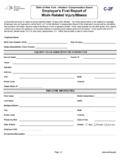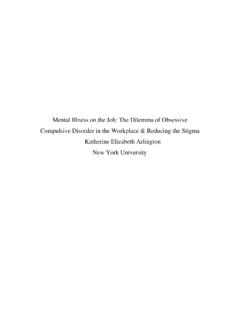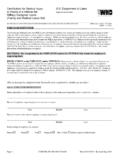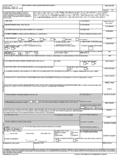Transcription of Prevention of heat illness in mines MINES07
1 Health and Safety Executive Prevention of heat illness in mines This guidance represents what is considered to be good practice by members of the Mining Industry Committee, and was prepared by their Occupational Health in mines sub committee. Members of the Occupational Health in mines committee: Mr G Gilmour Chairman, HM Inspectorate of mines , HSE. Mr A Allsop Union of Democratic Mineworkers Mr D Flack Federation of Independent mines photo: Martyn Pitt Mr S Hunneyball TES Bretby Mr S Jobling UK Coal Ltd Mr J R Leeming HM Inspectorate of mines , HSE. Mr D Mark Health and Safety Laboratory Dr R M Quinlan Business Healthcare Ltd Mr G Robinson Cleveland Potash Ltd Dr A Scott Senior Medical Inspector, HSE. Mr T Spurry UK Coal Ltd Mr R H G Young BACM/TEAM. Mr R Shepherd Secretary, HM Inspectorate of mines , HSE. Foreword This guidance provides useful and important information for mine management and mineworkers in deep hot mines that will help them avoid heat illness .
2 I welcome and fully support the advice given and recommend it to all in the industry. Dan Mitchell HM Chief Inspector of mines Chairman, Mining Industry Committee 1 of 14 pages Health and Safety Executive Introduction The Mining Industry Committee (MIC) is aware of studies that point to the possibility that some mineworkers can be subjected to such high levels of heat (and humidity) that they may suffer from heat illness . This guidance has been prepared to help employers and employees understand where this may occur in a mine, to recognise the symptoms and to ensure that any necessary control measures are understood and implemented. Employers in mines should use this guidance to assess whether such effects could occur, and take the recommended remedial action. Employees should follow the best practice advice in the guidance to minimise their risk of heat illness .
3 This guidance is intended to raise awareness and promote improvements between employers in mines and their employees and safety representatives. The MIC will continue to review the situation. Both management and the workforce must recognise that most workers in an adverse environment in a mine cannot take easy refuge from the conditions by opening a door and going outside, as in most other industries. The effects of heat illness must not be taken lightly, and steps must be taken to minimise the impact of the work environment, and to promote safe working practices within it. Relevant legislation The Health and Safety at Work etc Act 1974. The mines and Quarries Act 1954. The Management and Administration of Safety and Health at mines Regulations 1993. The Management of Health and Safety at Work Regulations 1999.
4 The Reporting of Injuries, Diseases and Dangerous Occurrences Regulations 1995. The Workplace (Health, Safety and Welfare) Regulations 1992. The Health and Safety (First Aid) Regulations 1981. Heat illness the hazard Working in high temperatures may not only cause heat illness and even death, but also loss of concentration leading to lowered productivity, and mistakes which can lead to accidents. Where humidity is relatively high, the hazard is increased. More heat strain is placed on a person as the Wet Bulb (WB) and Dry Bulb (DB). temperatures get closer. The absolute values of the temperatures are of less importance than the difference between them, as it is the relative humidity that causes the problem by inhibiting body cooling by the evaporation of sweat. For example, 28 oC WB/45 oC DB causes less heat strain than 32 oC WB/36 oC DB.
5 If the WB temperature rises above 32 oC, however, then substantial extra control measures should be implemented. The figure of 32 oC is derived from guidance published by the Institute of Occupational Medicine which recommends additional control measures above an effective temperature (explained later in this document). of 30 oC. Prevention of heat illness in mines 2 of 14 pages Health and Safety Health and Safety Executive Signs and symptoms of heat illness During work in hot conditions, the human thermo regulatory system tries to maintain the body core temperature at 37 oC. It does this by increasing blood flow to the skin to carry heat away from the core, and by causing sweating, the evaporation of which cools the skin and hence the blood. If this control is lost and the core temperature begins to rise, various physiological effects progressively result.
6 Initial symptoms These are: loss of interest in the task; difficulty in remaining alert; and the desire to seek more comfortable surroundings. Suppression of this desire may result in irritability. These initial symptoms progress to a loss of co ordination and dexterity, presenting significant safety and productivity implications. Heat rash Also known as prickly heat, heat rash is caused by unrelieved periods of constant perspiration, producing inflammation and blockage of the sweat ducts. This can result in areas of tiny red blisters, causing irritation and soreness. Heat rash can cause secondary problems with infections of the skin and is an indication of adverse conditions that may potentially cause heat stroke. Heat syncope (fainting). Heat syncope occurs when blood pools in the lower parts of the body, causing a temporary reduction in blood supply to the brain and hence a short term loss of consciousness.
7 Heat exhaustion Heat exhaustion results from the failure of the blood flow to adequately remove heat. A decrease in blood volume may result from dehydration caused by an inadequate intake of fluids. Alternatively, if a combination of environmental heat stress and work rate causes an excessively fast heartbeat, then the time interval between successive contractions of the heart muscles may be insufficient to maintain an adequate supply to the heart and, as a consequence, the rate of blood flow will drop. Core body temperature may rise to 39 oC. The symptoms of heat exhaustion are: tiredness, thirstiness, dizziness;. numbness or tingling in fingers and toes;. breathlessness, palpitations, low blood pressure;. blurred vision, headache, nausea and fainting;. clammy skin that may be either pale or flushed. Prevention of heat illness in mines 3 of 14 pages Health and Safety Executive Heat stroke This is the most serious of all heat related illnesses and may occur when the body core temperature exceeds 41 oC (it may reach 45 oC), and the co ordination of the involuntary nervous system including thermal regulation is affected.
8 Irreversible injury to the kidneys, liver and brain may occur. Heat stroke carries a high risk of fatality from cardiac or respiratory arrest, and must be treated as a medical emergency. Some symptoms of heat stroke are similar to those of less serious heat illnesses, ie headaches, dizziness, nausea, fatigue, thirst, breathlessness and palpitations, but the onset of illness may be sudden and dramatic, and pre existing heat exhaustion is not necessary. Additional symptoms of heat stroke can include: cessation of perspiration, the skin remains hot but is dry and may adopt a blotchy and red colouration, and the lips may take on a bluish tinge;. disorientation, which may become severe, including dilated pupils, a glassy stare and irrational aggressive behaviour;. shivering and other uncontrolled muscular contractions.
9 Loss of consciousness and convulsions. Risk assessment Some work activities carry an increased risk of heat illness , and should be avoided if possible. There are times, however, when there is no alternative to working in hot conditions and these circumstances require special consideration. Risk assessments should be made, safe systems of work designed and appropriate control measures introduced to control the duration and extent of exposure. Measures should follow the hierarchy of control defined in Schedule 1 of the Management of Health and Safety at Work Regulations 1999, ie: avoiding risks;. combating the risk at source;. adapting working practices;. giving collective protective measures priority over PPE;. giving appropriate instructions and training. Particular attention must be paid to the organisation of more physical work.
10 Examples of such activities include: setting supports;. pulling cables;. building conveyor structure;. manual handling tasks. Non acclimatised persons, eg contractors, service engineers etc working in the mine, may be at greater risk from heat illness . Management must ensure that employers other than the mine owning company understand the hazard, and that they and the mine management have assessed the risk and identified appropriate precautions. The employers of these categories of persons should ensure that their employees are fit for all the environments that they are likely to be exposed to in the course of their particular employment. Visitors should not normally be taken into areas where they would be exposed to high heat strain. Prevention of heat illness in mines 4 of 14 pages Health and Safety Executive Assessing the heat risk Several factors can influence the heat load on the body.
















